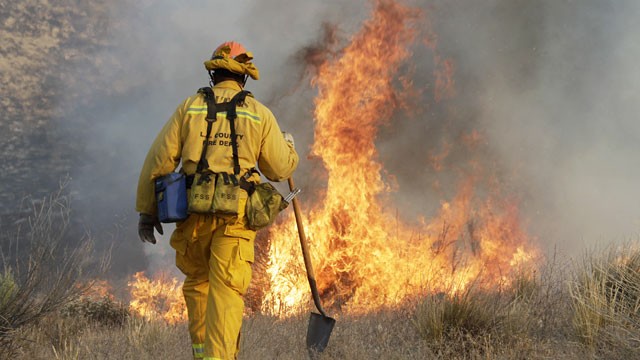

Firefighters working in darkness doubled containment of a massive wildfire north of Los Angeles to 40 percent overnight, as cool, moist air moved in Monday to replace torrid weather.
The fire expanded to more than 46 square miles but moved out of rugged mountains of the Angeles National Forest and onto the floor of the high desert Antelope Valley, where it became easier to fight.
"The fire moved into an area where vegetation changed from real dense to real sparse," said U.S. Forest Service spokesman Matt Corelli.
"We were able to engage it (at) 1- to 2-foot flame lengths versus 30-foot flame lengths," he added. "So you've got an area that we can get (to) and put troops right on the edge of the fire and stop its forward growth."
With only widely scattered homes in the area, firefighters will be able to work more on attacking flames than on structure protection, he said.
The cause of the fire was under investigation. Three firefighters had minor injuries, but no one else was hurt.
Named after an aqueduct station near the site where it erupted Thursday, the Powerhouse Fire burned furiously during the weekend as gusty winds swept the region and vegetation withered in triple-digit heat and humidity levels that plunged to single digits.
At least six houses were destroyed, 15 more were damaged, and 2,800 people fled 700 homes in the rural hamlets of Lake Hughes and Lake Elizabeth, 45 miles northwest of downtown Los Angeles.
Weather conditions changed dramatically Sunday night through early Monday with the arrival of a heavy dose of Southern California's "June gloom," a gray layer of wet marine air pushing deep inland from the Pacific.
"The flames really laid down overnight," said Nathan Judy, also of the Forest Service.
Firefighters halted the fire's progress on its northeastern front and were focusing the attack on the northwestern side.
"It's not in steep, rugged terrain anymore, so wind is our biggest factor right now, and heat," Corelli said.
Both factors, however, were expected to be more moderate. Winds were expected to range from 5 mph to 10 mph with gusts to 15 mph, compared to 40 mph gusts on Sunday. High temperatures were expected to be down in the low 90, with humidity percentages in the upper teens and 20s.
Despite the improved situation, evacuations remained in effect while firefighters checked communities for hazards such as hotspots, downed power lines, damaged gas lines and propane tanks.
The fire was fueled in part by chaparral that was "extremely old and dry" and hadn't burned since 1929, U.S. Forest Service Incident Commander Norm Walker.
About 2,100 firefighters took on the flames, aided by water-dropping aircraft, including three helicopters that stayed aloft through the night.
"We're putting everything that we have into this," Walker said.
George Ladd, 61, said among the structures burned was a cabin at Lake Hughes that his family had owned since 1954 but sold just last week.
"We had always worried about that thing going off like a bomb," Ladd said.
He walked through the ashes of his former cabin and the other destroyed homes on Sunday.
"All of them are nothing," Ladd said by phone from his home in nearby Palmdale. "A few scraps, a few pieces of wood with nails sticking out, but mostly just broken up concrete."
No comments:
Post a Comment